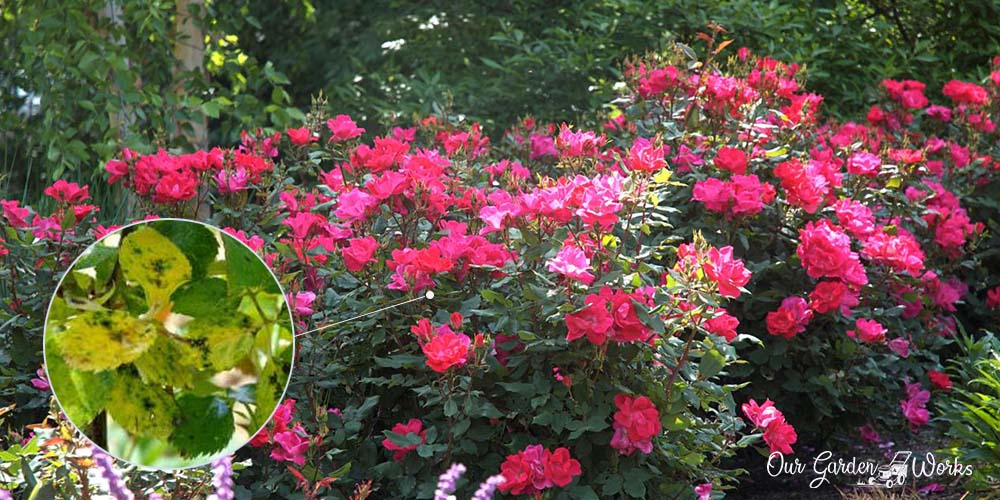Knockout roses are known as a low-maintenance and disease-resistant variety of roses. However, even the best type of roses can also experience leaf problems when you can’t meet their ideal conditions to thrive.
In this post, we will share what causes yellow leaves on knockout roses. We will also share some tips on taking care of them, so you can grow your knockout roses to their full potential.
Though knockout roses are self-reliant types of roses, you might still have a few questions about their behaviors.
What Causes Yellow Leaves on Knockout Roses?
The changes in leaf color can mean a lot of things. Yellow leaves are a natural part of the aging process in almost any plant.
However, it can also be a sign that your plant is under stress due to the following causes:
#1 Overwatering
As the leaves of plants breathe oxygen, so do their roots under the ground. Plant roots, microorganisms, and healthy microbes in the soil also need oxygen to perform their optimal function in nourishing your knockout roses.
With too much water or rain, the roots can drown and not absorb the soil nutrients. Thus, leading to yellow leaves, root rot, and stunted growth.
Knockout roses need about 16 to 18 inches of water every week. They prefer a long drink over a few intervals of watering. You have to let the soil dry out first before you water them again.
Perhaps, there are several rainfalls in your area, or you are watering them too frequently to cause the leaves to turn yellow.
Another possible cause of water issues in knockout roses is poor soil drainage.
If the soil has become too compact, it is tough for the roots to absorb oxygen and for the water to drain well. Thus, ending up with water stuck in the top layer of the soil and causing the roots to drown and rot.
What is the best soil for knockout roses?
The best type of soil for knockout roses is a mixture of ⅓ clay soil, ⅓ sandy soil, and more on compost or peat moss to encourage a balance between good water retention and soil drainage.
How to test soil drainage
To determine if overwatering or soil drainage is the cause of yellow leaves on knockout roses, try the following steps.
- Dig a small hole on the soil of your knockout roses.
- Fill it with water and let it drain.
- Fill it again, but this time, you will measure the amount of time when the first inch of water drains from the soil. An inch of water must drain every hour.
- If the soil doesn’t drain an inch of water within an hour, it’s a clear indication that your soil has poor drainage. On the other hand, if it drains in less than an hour, that means your knockout roses are at risk of drought stress.
#2 Nutrient Deficiency or Over-Fertilization
Nutrient deficiency is also another possible reason why the leaves turn yellow. Two factors can contribute to a nutrient deficiency in plants, including:
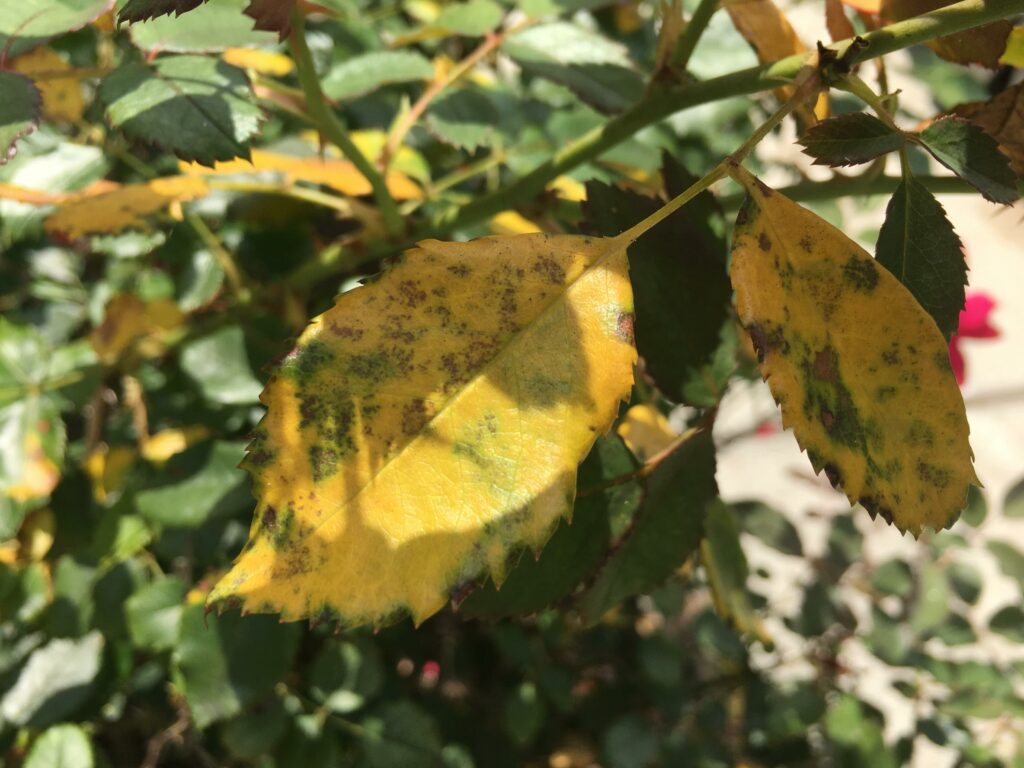
1. Improper Soil Acidity
Knockout roses grow and thrive in soil PH of 6.0 to 7.0, which means a slightly acidic neutral type of soil.
If it becomes too acidic or too alkaline, the roots will fail to get soil nutrients. Resulting in nutrient deficiency and leaves turning yellow.
Several factors can contribute to the change of PH levels in the soil, such as:
- Rainfall: Rainwater is combined with several compounds as it evaporates, condenses in the clouds, and falls from the sky. Thus, leading to increased soil acidity.
- High nitrogen content in fertilizers: Too much nitrogen acidifies the soil. It is the reason why most gardeners warn everyone about the use of coffee grounds. They are a good source of nitrogen. However, they are also acidic and can affect the nutrient absorption of plants.
- Inadequate fertilizer for roses: The ideal fertilizer for knockout roses is high in phosphorus content and balanced nitrogen and potassium levels. Consider using fertilizers for knockout roses than the standard 10-10-10.
Knockout roses cannot tolerate salt in the soil. Check for white crystals in the soil.
In case you see them, there might be an accumulation of salt in the soil from the fertilizers you used. You can pick the visible white crystals and leach the smaller ones with tap water.
#3 Extreme Weather
Knockout roses might be resistant to diseases but not with extreme heat and cold.
Any climate change can affect their behavior. The cold can trigger them to begin dormancy, while too much heat can result in leaf burns.
To prevent yellow leaves due to extreme temperatures, you need to relocate your knockout roses. Consider putting them in an area where the temperature is at 60 to 70 degrees Fahrenheit.
#4 Pest Infestation
Stressed knockout roses are also a magnet of pests that cause yellow leaves. Check out the common pests in knockout roses below:
(1) Aphids are tiny insects that suck honeydew or sugary sap on the leaves and stems of plants.
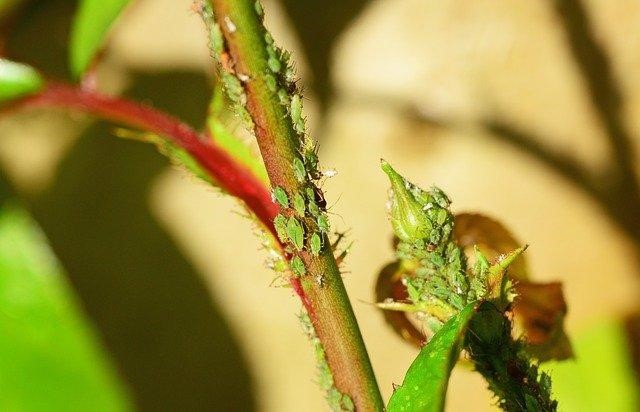
Heavy infestations of these insects can cause the leaves to yellow and wilt. They can even attract other pests in your plants like ants. They are often found on the top or the underside of leaves.
(2) Spider mites are the small relative of spiders and belong to the arachnid family.
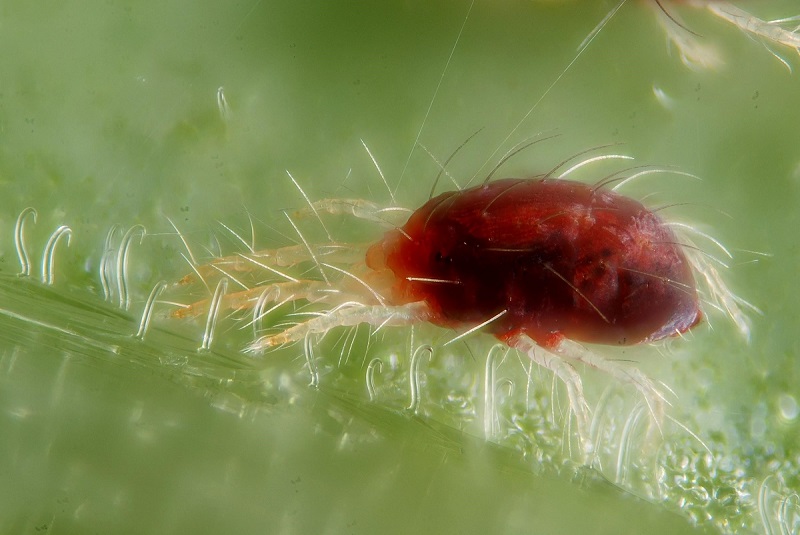
They stay under the leaves and feed off the plant by puncturing the leaf surface to extract sap. They often build white silk webs to protect themselves.
#5 Fungal Diseases
Though knockout roses are disease-resistant, they can still get fungal diseases like black spot disease and powdery mildew.
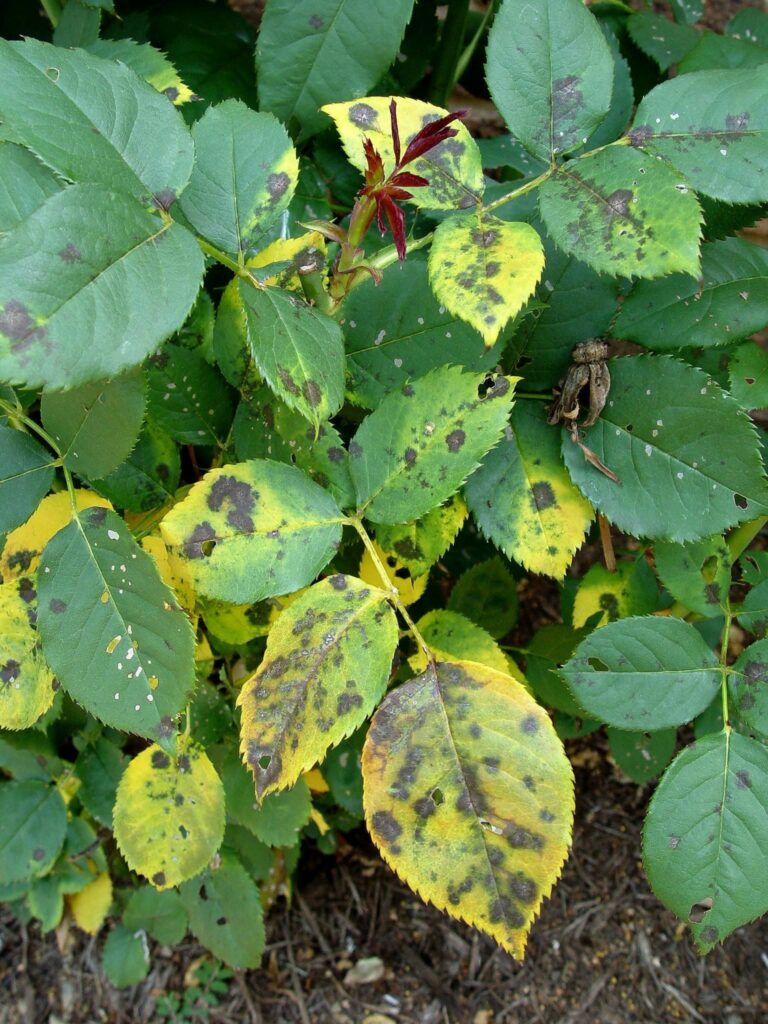
Signs of black spots with yellow halos are a clear indication of black spot disease.
Another disease that is common to roses is powdery mildew.
Powdery mildew is a fungal disease with fuzzy white splotches on the leaves and stems of plants. It usually spreads in humid weather and in areas where there is less air circulation. The signs of this disease will eventually subside as the weather changes.
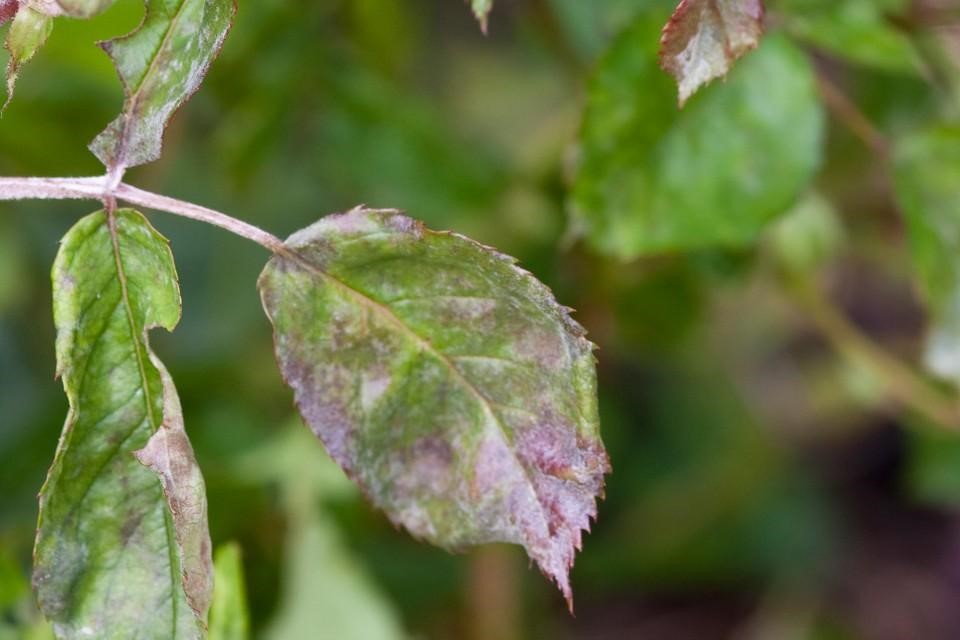
Though knockout roses can get back on their feet after a disease, it is beneficial to use a fungicide to treat them.
Here are some tips:
How to treat black spots and powdery mildew in knockout roses
- Remove the heavily damaged leaves with sanitized pruning shears. Dip the shears in a dish soap solution after every cut.
- Using a clean cloth, wipe the leaves with horticultural or neem oil to prevent the spores from spreading.
- Continue until the signs of the disease subside.
Plant Care Tips For Knockout Roses
Knockout roses may be low-maintenance, but it doesn’t mean you should leave them uncared for.
To provide the best care for your knockout roses, it’s essential to know the best condition for them to grow and thrive.
Here are the best conditions for your knockout roses:
1. Soil Requirements
Here are the best qualities of soil for knockout roses:
- A moist and well-draining soil
- Neutral soil with a soil PH level of 6.0 to 7.0.
- Mulched with wood chips to prevent weeds and protect lower leaves from soil-borne diseases.
- Transplant soil must be twice the size of the potting soil to give it enough room to grow.
- Must be mixed with compost and peat moss to improve the soil condition and encourage good soil drainage.
2. Sun Requirements
Knockout roses love the sun and need about 6 to 8 hours in direct sunlight every single day.
Place them in a sunny area in your house. They are the type of roses that produce more flowers, the more they get sun exposure.
3. Water Requirements
Knockout roses need 16 to 18 inches of water every week. They prefer to have a long drink or one watering rather than a few sips daily.
Also, to get the optimal water drainage, avoid using too much clay and sandy soil as they retain more moisture than other types of soil.
It is also essential to water knockout roses in containers more frequently. They tend to drain water more quickly than in-ground knockout roses. You should also check the moisture in the soil from time to time, especially during hot seasons.
Lastly, consider watering knockout roses at the base of the plant. You can do foliar watering but do it in the morning to give the leaves some time to dry out before nighttime. Avoid watering them at noon to prevent temperature shock in plants.
4. Fertilization
Knockout roses do not require the help of fertilizers. However, it also doesn’t hurt if you give them a boost in producing big and beautiful flowers.
A balanced fertilizer can help, but specific fertilizers for knockout roses will help them bloom better.
One of the best options in the market is Jobe’s Organics Knock Out Granular Rose Fertilizer. Fertilize your knockout roses after their first blooming cycle. You can also count on the nutrients found in compost and other organic sources like alfalfa meals.
Just be careful not to over-fertilize your plants to avoid salt formation beneath the soil.
Knockout roses are not a fan of salt, so you might want to check for some white crystals in the soil from time to time.
5. Pest and Disease Prevention
Knockout roses may be self-reliant and low-maintenance, but disease and pest resistance are not one of their strengths.
Here are some tips in keeping them from being a snack for hungry insects and lurking spores of diseases.
- Add mulch over the soil to prevent the spores in the soil from getting to the lower leaves.
- Always water at the base of the plants to avoid drenching the leaves. Wet leaves encourage the development of fungal diseases in plants.
- If the knockout rose has grown bushy, pruning them can encourage good air circulation throughout the plant.
- The presence of ants in your knockout roses doesn’t mean they are another pest to deal with. Ants are an indication that there are aphids on your plants. Ants feed on the honeydew that aphids get from your roses. Sometimes, there are even cases where they bring home the aphids themselves.
- Always clean your gardening tools before and after you use them. Doing so will not only keep them from rusting but also protect them from being a spore carrier. Spores are microscopic enough to transfer from contaminated to another plant.
- Only use insecticides for knockout roses, when the infestation is out of control. Consider using homemade insect sprays first before turning to chemical insecticides.
Here’s an easy insecticide recipe you can try at home:
Materials:
- 2 bulbs of garlic
- 1 quart of water
- ½ cup of vegetable oil
- 1 teaspoon of ground pepper
- 1 teaspoon of dish soap
- Strainer
- Spray bottle
Directions:
- Crush 2 bulbs of garlic using mortar and pestle or a garlic crusher.
- Mix the crushed garlic with water and let it sit for 12 hours.
- Add the vegetable oil, ground peppers, and dish soap.
- Drain the solution to remove the garlic bits.
- Transfer the solution to a spray and mix well before use.
Final Thoughts
Knockout roses are a tough variety of roses. However, as the song goes, even the best fall down sometimes. They are not pest-resistant and can still be infected with plant diseases.
The yellow leaves in knockout roses are most likely because of overwatering, pest infestation, temperature changes, and fungal diseases.
What makes them stand out during a pest infestation and disease infection is their ability to bounce back from the damage they endured.
We hope that this post provided you with some tips to help you keep your roses pretty and healthy.
Though you have an option to let them deal with pests and diseases on their own, it’s not bad to help them when they are stressed or under attack. After all, knockout roses are still plants that need your tender loving care.
If you find this post informative and helpful, please don’t forget to share it with your friends. Also, please leave a comment below about your experience in growing knockout roses.
